Deepak G. Pawar's Blog, page 8
January 15, 2019
God's own country? Not for Hindu God
Swami Ayyappa, Swami Ayyappa...Neene gatiyappa, nanage neene gatiyappa...
[O Lord Ayyappa... You are my only refuge...]
Thus sings Kerala's living legend Yesudas in an old Kannada film. (It would be very interesting to know the legend's views on the chaos unleashed by the Supreme Court's recent verdict on Sabarimala.)
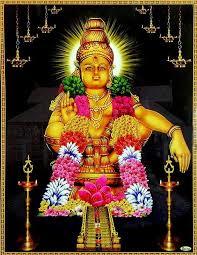
First of all, let's cast a glance on the mytho-history of the place. Lord Ayyappa, born of the union of Shiva and Vishnu (as Mohini), is also called Hari-Hara Putra for this reason. He was borne specifically to bring an end to the demoness Mahishi. After her annihilation at the hands of the Lord, Mahishi was released from her curse and was transformed into a beautiful maiden. She proposed marriage to the Lord. The Lord refused, but relented later by stating that he will marry her if and when His devotees stop appearing at his doorstep.
Malikapurathamma, as Mahishi is called today, is said to be waiting in a separate temple in the Sabarimala complex for such an eventuality to occur. As a mark of respect for her patience and sacrifice, women in the childbearing age voluntarily refrain from entering the sanctum of Lord Ayyappa.
Besides, the bhaktas of Lord Ayyappa are required to observe brahmacharya - complete celibacy for a period of 41 days before the Makara Sankranti (in mid-January every year) when they congregate at Sabarimala for the ensuing worship and festivities. The male bhaktas are required to wear the mala and black dress throughout the period of abstinence. They are to follow strict rituals and changes in lifestyle: not smoking/drinking, not consuming non-vegetarian diet, and crucially, abstaining from sex. (I have seen several patients, severe alcohol-dependents who have turned teetotalers during this period.)
A male bhakta is to look upon others as his brothers and sisters, and address his fellow bhaktas as 'Swami'/'Sami'. Basically, an average male follower transforms himself into something of a living saint during this period of purity and abstinence. Therefore, for the male bhaktas, contact with women in the reproductive age-group is strictly prohibited.
These, as far as I am aware, are the only reasons why women in childbearing age are disallowed from entering the holy sanctum at Sabarimala. And mind, the women in this age-group have been following this dictum voluntarily; they are not being oppressed or excluded from worship due to any patriarchal reasons.
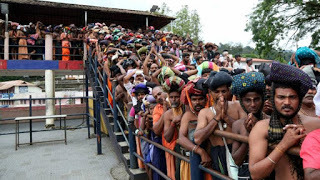
Having said all that, do we want the status quo to continue? Do we want women to be excluded from the sanctum, even due to the reasons cited above? Clearly not. We want them to enter the sanctum... eventually. We want the perception of purity to undergo a transformation that does not look at the act of menstruation as necessarily evil or impure. But such a change takes time.
All through the history of Indian society, there have been examples of arrival and settlement of alien cultures and traditions that went through the dual process of conflict, and adjustment and assimilation, before the syncretism that we see today became a reality. This is true of foreign invasion and occupation of India and the sociocultural changes thereof, the bhakti movement that originated from the need to negate ritualism and varna/jati system, the abolition of sati, the prevention of child-marriage, the laws against dowry system, saving and educating the girl child, decriminalization of homosexuality, etc. None of these occurred instantaneously: they came about only after several hundreds and thousands of years of conflict, adjustment, and finally, acceptance.
In time, with gradual change in opinions, through well-intentioned laws and acts, and altered public perception, the bigger transformation will come about. So the key word here is, eventually... eventually change will occur; it is not easy to change firmly entrenched cultural and religious notions by the single stroke of a tipsy judge's pen.
I say tipsy because the Honourable Judges of the Supreme Court seem to have acted on a whim - the kind that occurs to you after downing a peg or two. I further wonder if the Honourable Judges of the Supreme Court got out of the wrong side of the bed on the day, and said, "Yo dude! Let's do something rad today!" And then 4 of the 5 Judges decided to strike off the sacrosanct 800 year old religious custom at Sabarimala. (It is interesting to note that the one Judge who dissented was a woman.) I would like to call these four assenting Judges, the 'Rad 4'.
The present Keralite government is of course, chuffed, considering its manifesto appears to be aligned only against Hindu practices, and not any other religion's. The government, in all likelihood, arranged for the surreptitious entry of women in childbearing age-group into the sanctum. They also brought out a human wall of women in support of the Supreme Court's verdict. It was howlarious to watch interviews of burkha-clad women who hadn't a clue what they were doing there; one of them confessed her husband asked her to be there! Sorry mate, Irony, that's another death for you...
Apparently the Rad 4 were concerned about "equality, freedom of conscience and right to personal liberty" of [Hindu] women, and the fact that "to treat [Hindu] women as the children of a lesser God is to blink at the Constitution," and "placing the burden of men's celibacy on women stigmatizes them, stereotypes them." Noble... noble thoughts indeed!
I have added [Hindu] to the above statements since the Rad 4 appear to be concerned only about the welfare of Hindu women. Dear Honourable Rad 4, may I draw your attention to the following non-Sabarimala examples where women are so stigmatized and stereotyped that their plight blinks at the Constitution?
1. Girls/women are not allowed into the sanctum of the BAPS Swaminarayan Mandir. Yes, even infant girls are not allowed - I have experienced this first-hand.
2. Women are disallowed from attending Friday prayers in mosques.
3. Churches of many denominations do not have female priests/pastors because "only a baptised man validly receives sacred ordination".
4. Women of a certain religion are required to wear redundant head-cloths and dress up like walking bank vaults. They are considered to be the 'personal property' of their husbands with hardly any rights to property/divorce.
5. In a certain religion, polygamy is allowed, but polyandry is disallowed.
5. Preachers of a certain religion exhort their male adherents into carrying out certain acts that will get them a place in paradise where they will be served upon by virgins. Yes, nothing short of virgins would do for our intrepid heroes, when, after a hard day's bombing, they go to claim their just reward.
6. In certain religions, the inhuman and dangerous practice of female genital mutilation continues to date.
One could go on, of course, but you get the point? The legend of Sabarimala is a matter of faith - why target only Hindus' faith and not the faith of other religions? Conversely, why not go hammer and tongs at the regressive religious practices of other religions as well? In the absence of the latter, the question that begs to be asked is, does the Supreme Court possess the will, impartiality and courage to do so?
I am not holding my breath over it. However, until the Supreme Court does so, we can seek succour from the song quoted above.
Swamiye sharanam Ayyappa...!
Image sources:
https://www.hindugallery.com/lord-ayy...
https://www.moneycontrol.com/news/ind...
References:
https://www.speakingtree.in/allslides...
https://www.indiatoday.in/india/story...
https://indianexpress.com/article/ind...
https://en.wikipedia.org/wiki/Ordinat.... (Vatican Canon 1024: http://www.vatican.va/archive/ENG1104...)
[O Lord Ayyappa... You are my only refuge...]
Thus sings Kerala's living legend Yesudas in an old Kannada film. (It would be very interesting to know the legend's views on the chaos unleashed by the Supreme Court's recent verdict on Sabarimala.)

First of all, let's cast a glance on the mytho-history of the place. Lord Ayyappa, born of the union of Shiva and Vishnu (as Mohini), is also called Hari-Hara Putra for this reason. He was borne specifically to bring an end to the demoness Mahishi. After her annihilation at the hands of the Lord, Mahishi was released from her curse and was transformed into a beautiful maiden. She proposed marriage to the Lord. The Lord refused, but relented later by stating that he will marry her if and when His devotees stop appearing at his doorstep.
Malikapurathamma, as Mahishi is called today, is said to be waiting in a separate temple in the Sabarimala complex for such an eventuality to occur. As a mark of respect for her patience and sacrifice, women in the childbearing age voluntarily refrain from entering the sanctum of Lord Ayyappa.
Besides, the bhaktas of Lord Ayyappa are required to observe brahmacharya - complete celibacy for a period of 41 days before the Makara Sankranti (in mid-January every year) when they congregate at Sabarimala for the ensuing worship and festivities. The male bhaktas are required to wear the mala and black dress throughout the period of abstinence. They are to follow strict rituals and changes in lifestyle: not smoking/drinking, not consuming non-vegetarian diet, and crucially, abstaining from sex. (I have seen several patients, severe alcohol-dependents who have turned teetotalers during this period.)
A male bhakta is to look upon others as his brothers and sisters, and address his fellow bhaktas as 'Swami'/'Sami'. Basically, an average male follower transforms himself into something of a living saint during this period of purity and abstinence. Therefore, for the male bhaktas, contact with women in the reproductive age-group is strictly prohibited.
These, as far as I am aware, are the only reasons why women in childbearing age are disallowed from entering the holy sanctum at Sabarimala. And mind, the women in this age-group have been following this dictum voluntarily; they are not being oppressed or excluded from worship due to any patriarchal reasons.

Having said all that, do we want the status quo to continue? Do we want women to be excluded from the sanctum, even due to the reasons cited above? Clearly not. We want them to enter the sanctum... eventually. We want the perception of purity to undergo a transformation that does not look at the act of menstruation as necessarily evil or impure. But such a change takes time.
All through the history of Indian society, there have been examples of arrival and settlement of alien cultures and traditions that went through the dual process of conflict, and adjustment and assimilation, before the syncretism that we see today became a reality. This is true of foreign invasion and occupation of India and the sociocultural changes thereof, the bhakti movement that originated from the need to negate ritualism and varna/jati system, the abolition of sati, the prevention of child-marriage, the laws against dowry system, saving and educating the girl child, decriminalization of homosexuality, etc. None of these occurred instantaneously: they came about only after several hundreds and thousands of years of conflict, adjustment, and finally, acceptance.
In time, with gradual change in opinions, through well-intentioned laws and acts, and altered public perception, the bigger transformation will come about. So the key word here is, eventually... eventually change will occur; it is not easy to change firmly entrenched cultural and religious notions by the single stroke of a tipsy judge's pen.
I say tipsy because the Honourable Judges of the Supreme Court seem to have acted on a whim - the kind that occurs to you after downing a peg or two. I further wonder if the Honourable Judges of the Supreme Court got out of the wrong side of the bed on the day, and said, "Yo dude! Let's do something rad today!" And then 4 of the 5 Judges decided to strike off the sacrosanct 800 year old religious custom at Sabarimala. (It is interesting to note that the one Judge who dissented was a woman.) I would like to call these four assenting Judges, the 'Rad 4'.
The present Keralite government is of course, chuffed, considering its manifesto appears to be aligned only against Hindu practices, and not any other religion's. The government, in all likelihood, arranged for the surreptitious entry of women in childbearing age-group into the sanctum. They also brought out a human wall of women in support of the Supreme Court's verdict. It was howlarious to watch interviews of burkha-clad women who hadn't a clue what they were doing there; one of them confessed her husband asked her to be there! Sorry mate, Irony, that's another death for you...
Apparently the Rad 4 were concerned about "equality, freedom of conscience and right to personal liberty" of [Hindu] women, and the fact that "to treat [Hindu] women as the children of a lesser God is to blink at the Constitution," and "placing the burden of men's celibacy on women stigmatizes them, stereotypes them." Noble... noble thoughts indeed!
I have added [Hindu] to the above statements since the Rad 4 appear to be concerned only about the welfare of Hindu women. Dear Honourable Rad 4, may I draw your attention to the following non-Sabarimala examples where women are so stigmatized and stereotyped that their plight blinks at the Constitution?
1. Girls/women are not allowed into the sanctum of the BAPS Swaminarayan Mandir. Yes, even infant girls are not allowed - I have experienced this first-hand.
2. Women are disallowed from attending Friday prayers in mosques.
3. Churches of many denominations do not have female priests/pastors because "only a baptised man validly receives sacred ordination".
4. Women of a certain religion are required to wear redundant head-cloths and dress up like walking bank vaults. They are considered to be the 'personal property' of their husbands with hardly any rights to property/divorce.
5. In a certain religion, polygamy is allowed, but polyandry is disallowed.
5. Preachers of a certain religion exhort their male adherents into carrying out certain acts that will get them a place in paradise where they will be served upon by virgins. Yes, nothing short of virgins would do for our intrepid heroes, when, after a hard day's bombing, they go to claim their just reward.
6. In certain religions, the inhuman and dangerous practice of female genital mutilation continues to date.
One could go on, of course, but you get the point? The legend of Sabarimala is a matter of faith - why target only Hindus' faith and not the faith of other religions? Conversely, why not go hammer and tongs at the regressive religious practices of other religions as well? In the absence of the latter, the question that begs to be asked is, does the Supreme Court possess the will, impartiality and courage to do so?
I am not holding my breath over it. However, until the Supreme Court does so, we can seek succour from the song quoted above.
Swamiye sharanam Ayyappa...!
Image sources:
https://www.hindugallery.com/lord-ayy...
https://www.moneycontrol.com/news/ind...
References:
https://www.speakingtree.in/allslides...
https://www.indiatoday.in/india/story...
https://indianexpress.com/article/ind...
https://en.wikipedia.org/wiki/Ordinat.... (Vatican Canon 1024: http://www.vatican.va/archive/ENG1104...)
Published on January 15, 2019 06:25
January 5, 2019
Now they want to break Akshaya Patra
Yudhisthira, saddened by the fact that he was unable to feed the sages during the Pandavas' vanavasa, prayed to Surya.
Surya appeared before Yudhisthira and presented him with the Akshaya Patra: "This vessel will provide an inexhaustible supply of food every day..."
The Mahabharata
'Secularists' are at it again: they now want to break the great Bottomless Vessel that is Akshaya Patra, a gargantuan NGO endeavour that provides daily nourishment to 1.76 million children in 50,000 schools across 13 states of India.
Akshaya Patra, run by ISKCON, provides satvik food that does not include root vegetables and non-vegetarian fare. Already one state government in the South has terminated its contract with Akshaya Patra for not providing eggs in its mid-day meals. Now another southern state government is up in arms over the fact that Akshaya Patra does not include onion and garlic in its meals. Yes, seriously.
The Akshaya Patra is the world's largest school mid-day meal program. National Geographic has made a documentary on the hygienic and efficient manner in which meals are prepared everyday in Akshaya Patra's kitchens and delivered to schools in time for the lunch break.
But the state governments are not satisfied. Neither do these state governments provide quality meals, nor do they let a successful scheme continue. They are doing what they are best at: making a meal of a successful program; just like they did with ICDS. Now its the turn of mid-day meal scheme.
If these state governments are so bothered by the "lack of nutritional value", in that the Akshaya Patra meals do not include eggs, onions and garlic, why don't they provide these "essential nutrients" on their own? That is, in addition to what Akshaya Patra is providing, and to those children who want to eat these food items.
Even better, these state governments can infinitesimally enhance the nutritional value of school mid-day meals by investing in raising, killing and distributing animal meat such as chicken, mutton, fish, seafood, venison and bacon. And even beef, why not?
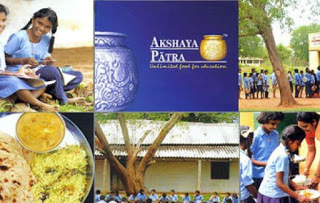
If you thought the state governments were meddlesome, wait till you hear what a 'doctor' from 'Right to Food' campaign had to say about Akshaya Patra. According to her, Akshaya Patra is run by a Brahmin organization that misleads people into believing that non-vegetarianism is bad.
She believes that Brahmins are behind the evil public policies enacted in India. She says they hamper the development of the country with their unscientific practices. She welcomes the termination of contract with Akshaya Patra in one state, and goes on to suggest that "Brahmins should be actively taken out of certain key spaces."
Say what, lady? Brahmins exterminated? Now, why does this sound familiar...? Ah yes... WW2, Germany, Jews, Holocaust... yes, now I remember.
Perhaps the said 'doctor' belongs less to 'Right to Food' than to 'Right to Convert'?
Funny, she does not find what missionaries from her own religion are doing to the country objectionable. How about stopping preaching faith in missionary schools and colleges? How about giving up the practice of thrusting faith-healing prayers on hapless patients and their relatives in missionary hospitals? How about not reaching out to the poor with the ostensible aim of providing healthcare, when the actual aim is to proselytize?
[P.S.: I do not condone the beef-ban. I believe it should not exist; governments should not be telling people what they can eat or not eat. But personally, I am a believer in ahimsa and vegetarianism. And I have busted the myth that vegetarian diet is not nutritious in this article.]
What's disgusting in this whole affair is that the shortsighted state government officials are heeding the advice given them by breaking-India forces such as the Right to Food 'doctor'. As a result, India is about to lose yet another wonderful initiative that is worth its weight in gold.
So, here's hoping that Akshaya Patra continues to grow, and goes on to cover all the schools across India.
References:
https://jayarama.wordpress.com/2010/0...
https://www.deccanherald.com/opinion/...
https://www.opindia.com/2018/12/activ...
Image source:
https://www.udayavani.com/english/new...
Surya appeared before Yudhisthira and presented him with the Akshaya Patra: "This vessel will provide an inexhaustible supply of food every day..."
The Mahabharata
'Secularists' are at it again: they now want to break the great Bottomless Vessel that is Akshaya Patra, a gargantuan NGO endeavour that provides daily nourishment to 1.76 million children in 50,000 schools across 13 states of India.
Akshaya Patra, run by ISKCON, provides satvik food that does not include root vegetables and non-vegetarian fare. Already one state government in the South has terminated its contract with Akshaya Patra for not providing eggs in its mid-day meals. Now another southern state government is up in arms over the fact that Akshaya Patra does not include onion and garlic in its meals. Yes, seriously.
The Akshaya Patra is the world's largest school mid-day meal program. National Geographic has made a documentary on the hygienic and efficient manner in which meals are prepared everyday in Akshaya Patra's kitchens and delivered to schools in time for the lunch break.
But the state governments are not satisfied. Neither do these state governments provide quality meals, nor do they let a successful scheme continue. They are doing what they are best at: making a meal of a successful program; just like they did with ICDS. Now its the turn of mid-day meal scheme.
If these state governments are so bothered by the "lack of nutritional value", in that the Akshaya Patra meals do not include eggs, onions and garlic, why don't they provide these "essential nutrients" on their own? That is, in addition to what Akshaya Patra is providing, and to those children who want to eat these food items.
Even better, these state governments can infinitesimally enhance the nutritional value of school mid-day meals by investing in raising, killing and distributing animal meat such as chicken, mutton, fish, seafood, venison and bacon. And even beef, why not?

If you thought the state governments were meddlesome, wait till you hear what a 'doctor' from 'Right to Food' campaign had to say about Akshaya Patra. According to her, Akshaya Patra is run by a Brahmin organization that misleads people into believing that non-vegetarianism is bad.
She believes that Brahmins are behind the evil public policies enacted in India. She says they hamper the development of the country with their unscientific practices. She welcomes the termination of contract with Akshaya Patra in one state, and goes on to suggest that "Brahmins should be actively taken out of certain key spaces."
Say what, lady? Brahmins exterminated? Now, why does this sound familiar...? Ah yes... WW2, Germany, Jews, Holocaust... yes, now I remember.
Perhaps the said 'doctor' belongs less to 'Right to Food' than to 'Right to Convert'?
Funny, she does not find what missionaries from her own religion are doing to the country objectionable. How about stopping preaching faith in missionary schools and colleges? How about giving up the practice of thrusting faith-healing prayers on hapless patients and their relatives in missionary hospitals? How about not reaching out to the poor with the ostensible aim of providing healthcare, when the actual aim is to proselytize?
[P.S.: I do not condone the beef-ban. I believe it should not exist; governments should not be telling people what they can eat or not eat. But personally, I am a believer in ahimsa and vegetarianism. And I have busted the myth that vegetarian diet is not nutritious in this article.]
What's disgusting in this whole affair is that the shortsighted state government officials are heeding the advice given them by breaking-India forces such as the Right to Food 'doctor'. As a result, India is about to lose yet another wonderful initiative that is worth its weight in gold.
So, here's hoping that Akshaya Patra continues to grow, and goes on to cover all the schools across India.
References:
https://jayarama.wordpress.com/2010/0...
https://www.deccanherald.com/opinion/...
https://www.opindia.com/2018/12/activ...
Image source:
https://www.udayavani.com/english/new...
Published on January 05, 2019 06:48
November 28, 2018
A Sentinel Event
An open plea to the relevant Government departments:
Dear Sir/Madam
The Sentinelese have shown us the way. They have shown you, the Government, the way to deal with unwanted intrusions and unruly behaviour by foreign elements.
Shame on our national defence and security systems, that one missionary could bribe local fishermen and gain access to the protected island not less than five times.
That the Sentinelese have a protected area - however tiny - to call their own and to follow their own customs and regulations in their own space, is revealing.
It also shows that on the so-called civilized and secular mainland, we are unable to safeguard our own interests from the virus of conversions and misdemeanours of illegal immigrants and foreign criminals.
Over the last few months, there have been several incidences of crime by these very same visa-dodgers and over-stayers. Many illegal immigrants have procured passport/Aadhar/voter cards through racketeers.
In certain parts of Bengaluru, for example, foreign elements have formed enclaves of their own - 'foreign Sentinelese' areas, if you like, that are no-go areas for 'locals'/'natives', as they call us.
Go through page three crime news in any newspaper these days. Nepalese, Bangladeshi and/or African nationals figure prominently in such crimes as drug-dealing, prostitution, petty theft and drunken driving.
Are those foreign criminals that are caught - if at all - by the police, deported to their country of origin, after they are punished by our legal system - if at all?
While law and order problems continue unabated, the other unseen breaking-India force, to quote Rajiv Malhotra, continues its surreptitious accumulation of masses of gullible public into its dragnet. I am talking about evangelism and religious conversions.
The Andaman incident is only the tip of the iceberg; one that made it to news reports because of what happened to the missionary. Unseen, unchecked, unabated, other missionaries carry on in their merry ways all across the mainland - from coastal Andhra and Orissa, to northern Karnataka, to even Punjab. Indeed, no state is exempt from their proselytizing activities.
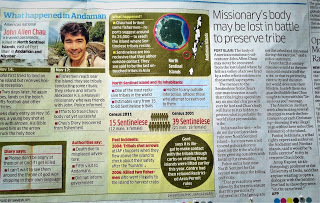
What are you doing to check these threats to national security and Sanatana Dharma?
Cutting off foreign funding to these so-called NGOs was a good move, but it does not seem to be enough anymore. Declare all conversions illegal. Put the onus of proving willingness to convert on these NGOs by officially registering and/or restricting their activities. Send officials/volunteers to remote areas where missionaries are most active, to counter-educate the gullible public as to the futility of conversions. Even better, improve the living conditions of vulnerable populations, and provide them with good healthcare and education so that they do not have to depend on proselytizing NGOs.
Kick out visa over-stayers and illegal immigrants. Come down hard on the passport/Aadhar/voter card procurement racket. Make sure that foreign criminals are compulsorily deported with no chance of return, after they have served out their prison sentences.
For god's sake, do something. And do it NOW, before it's too late.
Else, be prepared to deal with race-riots and Sentinel-type direct action even on the mainland.
Thank you
A 'local'/'native' citizen
Image sources:
https://www.businessinsider.com/ameri...
Deccan Herald, page 11, 25th November 2018
Dear Sir/Madam
The Sentinelese have shown us the way. They have shown you, the Government, the way to deal with unwanted intrusions and unruly behaviour by foreign elements.
Shame on our national defence and security systems, that one missionary could bribe local fishermen and gain access to the protected island not less than five times.
That the Sentinelese have a protected area - however tiny - to call their own and to follow their own customs and regulations in their own space, is revealing.
It also shows that on the so-called civilized and secular mainland, we are unable to safeguard our own interests from the virus of conversions and misdemeanours of illegal immigrants and foreign criminals.

Over the last few months, there have been several incidences of crime by these very same visa-dodgers and over-stayers. Many illegal immigrants have procured passport/Aadhar/voter cards through racketeers.
In certain parts of Bengaluru, for example, foreign elements have formed enclaves of their own - 'foreign Sentinelese' areas, if you like, that are no-go areas for 'locals'/'natives', as they call us.
Go through page three crime news in any newspaper these days. Nepalese, Bangladeshi and/or African nationals figure prominently in such crimes as drug-dealing, prostitution, petty theft and drunken driving.
Are those foreign criminals that are caught - if at all - by the police, deported to their country of origin, after they are punished by our legal system - if at all?
While law and order problems continue unabated, the other unseen breaking-India force, to quote Rajiv Malhotra, continues its surreptitious accumulation of masses of gullible public into its dragnet. I am talking about evangelism and religious conversions.
The Andaman incident is only the tip of the iceberg; one that made it to news reports because of what happened to the missionary. Unseen, unchecked, unabated, other missionaries carry on in their merry ways all across the mainland - from coastal Andhra and Orissa, to northern Karnataka, to even Punjab. Indeed, no state is exempt from their proselytizing activities.

What are you doing to check these threats to national security and Sanatana Dharma?
Cutting off foreign funding to these so-called NGOs was a good move, but it does not seem to be enough anymore. Declare all conversions illegal. Put the onus of proving willingness to convert on these NGOs by officially registering and/or restricting their activities. Send officials/volunteers to remote areas where missionaries are most active, to counter-educate the gullible public as to the futility of conversions. Even better, improve the living conditions of vulnerable populations, and provide them with good healthcare and education so that they do not have to depend on proselytizing NGOs.
Kick out visa over-stayers and illegal immigrants. Come down hard on the passport/Aadhar/voter card procurement racket. Make sure that foreign criminals are compulsorily deported with no chance of return, after they have served out their prison sentences.
For god's sake, do something. And do it NOW, before it's too late.
Else, be prepared to deal with race-riots and Sentinel-type direct action even on the mainland.
Thank you
A 'local'/'native' citizen
Image sources:
https://www.businessinsider.com/ameri...
Deccan Herald, page 11, 25th November 2018
Published on November 28, 2018 04:57
October 9, 2018
India's got #MeToo
We know that India's got talent... oodles of it, both within Bollywood and outside.
Now India's got #MeToo...
They say everything happens at the right time. Ten years ago, when the said actress was sexually harassed, had she made her revelations, they may not have had such an impact as they have done now.
(I am, of course, assuming that the allegations are true; but that's something the courts would have to decide. But the very fact that the issue has been brought out by one individual is to be welcomed.)
Now that cat's out of the bag, we need to make the most of it. Thank goodness that #MeToo happened in Hollywood - indeed, for a change, that's one good thing that needs to be welcomed to our shores.
Let's hope the movement gathers steam here too and more sacrosanct skeletons tumble out of the hitherto locked up Bollywood cupboard.
Indeed that cupboard was so tightly shut and its inhabitants so much in denial about the transgressions of the high and mighty that it was all bordering on a collective psychotic state.
Even now that the issue is finally out in the open, the reactions have been reflective of this psychotic state.
The glorious superstars of Bollywood have completely denied to comment on it, or to even acknowledge that such incidences could occur in their hallowed citadel. These are hypocritical, self-serving, fake superstars who are only thriving in the industry due to the blind adulation of their equally psychotic fans.
One hopes that at the very least, the other women of the film industry finally find their long-suppressed voice and come out in support of the movement. And not only women, men who have been abused should come out too.
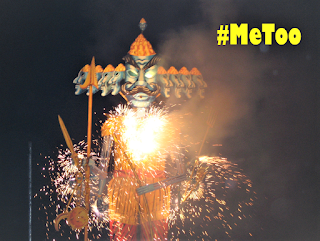
There was a recent post on social media that showed a battered face of a goddess with the tagline that went something like this: 'For the next 10 days the country that abuses its women will celebrate female power' (with reference to Dussehra). Sad, but true!
One may be super talented and highly regarded, yet guilty of sexual harassment at work place. Like many of the other legal directives, the Vishaka Guidelines exist mainly on paper, with companies loath to fully implement them, and employees blissfully unaware of their existence.
Now that the #MeToo Ravana has been dragged out kicking and screaming into the spotlight, here's hoping that the #MeToo movement drags out more such Ravanas from other citadels too: sports, politics, corporate and yes, even medical field.
Then there can be the collective burning of the #MeToo Ravana effigies, which would light up this year's Dussehra like no other.
Primary image source: https://commons.wikimedia.org/wiki/Fi...
Now India's got #MeToo...
They say everything happens at the right time. Ten years ago, when the said actress was sexually harassed, had she made her revelations, they may not have had such an impact as they have done now.
(I am, of course, assuming that the allegations are true; but that's something the courts would have to decide. But the very fact that the issue has been brought out by one individual is to be welcomed.)
Now that cat's out of the bag, we need to make the most of it. Thank goodness that #MeToo happened in Hollywood - indeed, for a change, that's one good thing that needs to be welcomed to our shores.
Let's hope the movement gathers steam here too and more sacrosanct skeletons tumble out of the hitherto locked up Bollywood cupboard.
Indeed that cupboard was so tightly shut and its inhabitants so much in denial about the transgressions of the high and mighty that it was all bordering on a collective psychotic state.
Even now that the issue is finally out in the open, the reactions have been reflective of this psychotic state.
The glorious superstars of Bollywood have completely denied to comment on it, or to even acknowledge that such incidences could occur in their hallowed citadel. These are hypocritical, self-serving, fake superstars who are only thriving in the industry due to the blind adulation of their equally psychotic fans.
One hopes that at the very least, the other women of the film industry finally find their long-suppressed voice and come out in support of the movement. And not only women, men who have been abused should come out too.

There was a recent post on social media that showed a battered face of a goddess with the tagline that went something like this: 'For the next 10 days the country that abuses its women will celebrate female power' (with reference to Dussehra). Sad, but true!
One may be super talented and highly regarded, yet guilty of sexual harassment at work place. Like many of the other legal directives, the Vishaka Guidelines exist mainly on paper, with companies loath to fully implement them, and employees blissfully unaware of their existence.
Now that the #MeToo Ravana has been dragged out kicking and screaming into the spotlight, here's hoping that the #MeToo movement drags out more such Ravanas from other citadels too: sports, politics, corporate and yes, even medical field.
Then there can be the collective burning of the #MeToo Ravana effigies, which would light up this year's Dussehra like no other.
Primary image source: https://commons.wikimedia.org/wiki/Fi...
Published on October 09, 2018 06:26
September 23, 2018
The coco-nutty professor
A Harvard professor has gone on record declaring coconut oil to be "pure poison."
That's it for you Keralites.... you have been consuming poison all these thousands of years! Now that the good professor has declared it, you will soon be extinct.
Apparently professor's nutty video has gone viral... it might as well have gone bacterial.
For it is typical of the toxicity and condescending attitude western academicians have towards all things eastern. This stems from a deep level of ignorance of the frogs in the western well for whom there isn't anything worth considering outside of their own narrow well.
Even if coconut oil were to be rich in saturated oil, to declare it to be pure poisonous is... well, rich, coming from the society that loves its Coca Colas, Pepsis, McDonald's and KFCs.
Sugar is poisonous. So is alcohol. So is smoking.
Driving is hazardous. So is flying.
Eating meat is unethical and unhealthy.
Yet people go about merrily indulging in all these on a daily basis.

In India, it is inconceivable to imagine life without the coconut tree and its many products featuring prominently in daily affairs.
From cooking to hair oil to rope making to fuel to religious rituals to even carrying you on your last journey to the crematorium, the ubiquitous coconut tree is as useful, versatile and sacred as the cow.
Coconut oil has more fat than lard, the professor says. But we haven't yet arrived at the most perfect health-friendly food suitable for the entire population... research is ongoing.
You can't gulp down bottles of olive oil just because it has more PUFA. Oil is oil. Use it sparingly and judiciously. Whether it is sunflower, safflower, olive, canola, groundnut or coconut oil.
Image source: https://www.prevention.com/beauty/a20...
Published on September 23, 2018 07:39
August 13, 2018
Re Osho
Was Osho killed? Murdered by the US government?
That's the thought that remains with you as you finish Osho's 'autobiography'. Although Osho has been credited as the author of Autobiography of a Spiritually Incorrect Mystic, it has been put together by his followers. I was interested in finding out about the life of the man behind all those seemingly outrageous opinions and meditative techniques. And it makes for a fascinating read.
Equally fascinating, and some might say, titillating, are the 2 Netflix documentaries on Osho: Wild Wild Country and Guru: Bhagwan, His Secretary & His Bodyguard.
From these readings and viewings, the philosophy of the most charismatic spiritual leaders of our times becomes apparent - somewhat. It is not possible to glean his entire thought process and methodology even if you happened to be a close confidante.
Perhaps, in many ways, it is meant to be that way. Spiritual mystics are meant to be inscrutable and unfathomable - one of Osho's methods was to shock/titillate his followers into some kind of awakening.
Hence you find him, at various times, being jovial, being disinhibited, being cantankerous, lashing out at religious practices, advocating dynamic meditation, advising followers to have sexual contact with each other, owning a fleet of Rolls Royces, using drugs, etc, etc.
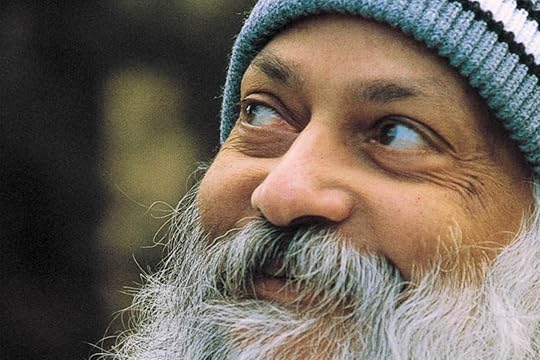
But at no other time was his controversial philosophy debated, abhorred and targeted more than during his disastrous stay in America. This is addressed very well in the 2 documentaries, especially in the 6-part Wild Country.
One can't help wondering, in hindsight, why his secretaries ever select this place for his commune? Did they honestly believe that the conservative Christian local population would put up with such practices as personal meditation and sexual expression (as opposed to repression)?
Promptly, the Americans - both the general public and the legal/administrative leaders - reacted as they continue to do towards anything that they see as a threat to their faith, culture and nationhood (remember WMD?). They came down like a ton of bricks on the nascent community with multiple legal proceedings and forced Osho to agree to flee US.
His commune did not help its own cause with its in-your-face attitude and infighting - mostly by Osho and his two groups of close confidantes. When it mattered most, Osho himself could have practised silence, as he most often did in his commune. But he came out with allegations against his secretary, Ma Ananda Sheela, which opened the doors to the final, decisive legal proceedings.
What's not shown in the documentaries (but is mentioned in the book) is that Osho was hounded by the US, and had to move from country to country after his legal settlement in US because he was denied asylum wherever he landed. Sadly, he experienced this even in India, thanks to the bullying tactics by the 'Policeman of the World'. It is particularly disgusting to know how the US president arm-twisted the president of the one country that did give him asylum - Uruguay (by threatening to impose sanctions), and compelled him to expel Osho.
As if that weren't enough, it is also said that Osho died from the effects of thallium poisoning carried out by the US state during his incarceration in US jails. I wouldn't be surprised if the Vatican influenced the US government in persecuting Osho, as later media reports speculated.
Coming to more positive findings from my Osho study. Osho's philosophy struck me as being crystal clear with regards to what matters and what does not in spiritual life. This is evident even from his early life experiences. In the book, he gives a vivid description of his enlightenment moment. There are also hilarious anecdotes of how the child Osho confronted a Jain monk at his grandparents' house with unanswerable questions; and how he conducted his classes when he later became professor at a college - very informally and irreverently, much to the chagrin of his exasperated principal. He also gives rational explanations to most of his seemingly outlandish whims and fancies.
Osho dedicates a chapter to understanding mental health issues, as they are studied and practised in the West. He says, 'Sigmund Freud introduced psychoanalysis into the world. It is rooted in analyzing the mind. It is confined to the mind... The goal of Freudian psychoanalysis is not very great. The goal is to keep people normal. But normality is not enough...' Instead, Osho advocates standing out of one's mind - or ecstasy, or transcending the mind itself.
Broadly, I agree with two particular philosophies of Osho: his critique of organised religions, and the need to address repressed emotions and sexual impulses.
Osho is unsparing in his criticism of organised religions; none of the major religions of India and the world escape his irreverence towards them. And here's the thing - his criticism does not feel exaggerated; indeed one would be hard-pressed to come up with an acceptable counter-argument to his criticism. Basically, Osho advocates stripping Faith of all its unhelpful coverings - rituals, rigidities and falsehoods - leaving only the spiritual core that really matters.
For repressed emotions, he advocates (among many others) a meditative technique that involves 'boiling up' oneself through rapid breathing, letting go of pent up and repressed emotions through crying/yelling/thrashing out, and finally observing a period of silence.
He rightly points out that it is only after these repressed emotions are sublimated, the mind becomes conducive to meditation, which requires stillness and silence from within.
Some of the other Osho gems that I picked up from the book are given here:
On learning:Why is every language called the mother tongue? Because the mother speaks and the father listens - and that's how the children learn. That's how I learned.
On living life:Once you are ready to say, "I don't care about respectability," then the society is absolutely impotent to do anything against your will.
On religion:All holy books are corpses, dead flowers and nothing else... Truth, the living truth, has to be discovered by each individual by himself. Nobody can give it to you.The moment truth is organized, it becomes a lie. An organized religion is nothing but a hidden politics, a deep exploitation by the priesthood. They may be shankaracharyas, imams, rabbis, or popes - it makes no difference.True religion has no name, it cannot have any name. Buddha lived, Jesus lived it - but remember Jesus was not a Christian and Buddha was not a Buddhist, he had never heard of the word. The truly religious people have been simply religious, they have not been dogmatic. ...Christianity has not developed the science of meditation in any way. It has remained a very mediocre religion; so is Judaism.
On meditation:Enlightenment is a very individual process. Every person passes through different phases, because every person in many lives has gathered different kinds of conditionings.You cannot do meditation, you can only be in meditation... Dhyana is dropping all contents of the mind and just being.
Osho's message:I am an incurable dreamer. But I can say to you that whatever I have dreamed in my life, I have managed it without doing anything. Just a proposal to existence.Be in the world, but don't be of it. Live in the world, but don't allow the world to live in you. That's my message...
So, here's what I have to say:
Osho may have been killed. But Osho-hood continues to thrive, and draw in adherents by the millions; his message lives on. You can adore Osho; you can hate Osho. But ignore him and his message at your own peril.
Image source: https://realization.org/img/osho.3.15...
Published on August 13, 2018 08:02
June 19, 2018
IPL 2018: hits and misses
This year, one expected a lot from IPL since there was a general rearrangement of teams following the big auction. One would have thought that we would get to see a more balanced contest, instead of the same old teams dominating others.
But, no such luck... the same old teams dominated others. CSK and SRH continued in their merry way, in spite of the former coming back after the two-year hiatus, and the latter losing its Aussie captain due to the ball tampering row. Even more familiar: RCB continued its woeful run in the IPL.
Here's a low down on this year's edition; the hits and misses; the good, bad and the ugly part of the annual cricketing event that fills our summer holidays, and that we have come to love so much.
If you leave out the doubters and naysayers. They are usually bothered by 'commercialization,' 'match-fixing,' 'loss of purity of cricket,' and what not, all conjured up and exaggerated to vilify India's sporting sensation.
I ask them these: When was the last time an Indian sporting event garnered so much global attention? When did foreign players ever show so much interest in an Indian sporting event, so much so that getting picked in the auction is a matter of pride and fortune for them? When was the last time, a rattled global (read mostly English) cricketing community pour out so much vitriol towards an Indian cricketing phenomenon, a sure sign of their underlying insecurity and jealousy?
That's right... NEVER!
So peeps, take the chill pill, sit back and enjoy the cricketing action. As with every other sport, there are bound to be the bad apples that are up to no good, which of course does not mean that the other players, the game itself, or the fans should pay the price.
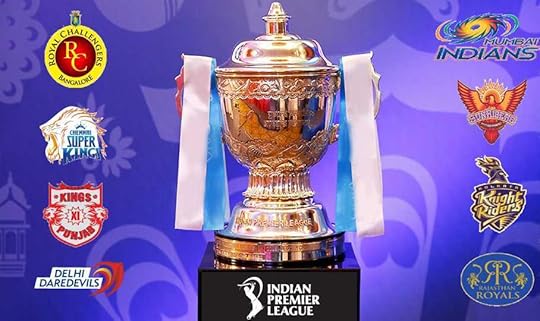
Here are my observations from the 2018 contest, some good, some bad.
Good Even though the usual suspects dominated, the two best teams in this year's tournament - CSK and SRH - made it to the finals. It was good that the other lesser teams did not sneak in due to some fortuitous twist in the tail. My tweet:2 best teams #CSKvSRH have made it to the #IPL2018Final and 4 of the calmest minds in cricket - MSD, Fleming, Williamson & Moody are at the helm; just goes to show that even in the rough & tumble, slam bang version of cricket, calmness of mind matters [image error]
But, no such luck... the same old teams dominated others. CSK and SRH continued in their merry way, in spite of the former coming back after the two-year hiatus, and the latter losing its Aussie captain due to the ball tampering row. Even more familiar: RCB continued its woeful run in the IPL.
Here's a low down on this year's edition; the hits and misses; the good, bad and the ugly part of the annual cricketing event that fills our summer holidays, and that we have come to love so much.
If you leave out the doubters and naysayers. They are usually bothered by 'commercialization,' 'match-fixing,' 'loss of purity of cricket,' and what not, all conjured up and exaggerated to vilify India's sporting sensation.
I ask them these: When was the last time an Indian sporting event garnered so much global attention? When did foreign players ever show so much interest in an Indian sporting event, so much so that getting picked in the auction is a matter of pride and fortune for them? When was the last time, a rattled global (read mostly English) cricketing community pour out so much vitriol towards an Indian cricketing phenomenon, a sure sign of their underlying insecurity and jealousy?
That's right... NEVER!
So peeps, take the chill pill, sit back and enjoy the cricketing action. As with every other sport, there are bound to be the bad apples that are up to no good, which of course does not mean that the other players, the game itself, or the fans should pay the price.

Here are my observations from the 2018 contest, some good, some bad.
Good Even though the usual suspects dominated, the two best teams in this year's tournament - CSK and SRH - made it to the finals. It was good that the other lesser teams did not sneak in due to some fortuitous twist in the tail. My tweet:2 best teams #CSKvSRH have made it to the #IPL2018Final and 4 of the calmest minds in cricket - MSD, Fleming, Williamson & Moody are at the helm; just goes to show that even in the rough & tumble, slam bang version of cricket, calmness of mind matters [image error]
Published on June 19, 2018 23:03
May 5, 2018
Oh...! the agony of being an RCB fan!
The pain... the suffering... the agony... of being an RCB fan is beyond description.
Consider this: Glamorous big-ticket franchise - on paper. Marquee players, with 2 best batsmen in the world - on paper. Hype and hoopla, bold proclamations - on paper. #eesalacupnamde and #playbold - on (e-)paper. 'Pirate' cheerleaders with the guy in the middle (!), trying to be funny with the slogans with godawful dance moves - on paper... okay, the last one is on stage.
But NOTHING on the ground. Zero results to show. Not a single silverware in the cupboard since the last 11 years.
No doubt, RCB have come close on a few occasions, but have not provided the finishing flourish. If ever there was a team in the IPL that flatters to deceive its fans, it must be RCB.
Kevin Pietersen said during the beginning of this year's (2018) IPL that 'the potential of this team is sky high'. Sadly that potential has also remained only on paper.
They may yet turn a corner this year, but it is highly unlikely (they have just lost the return match against CSK on 5th May as I write this).
Year after year, for the diehard RCB fan, it is a familiar story: more misses than hits, agony as the batsmen fall cheaply to innocuous bowlers, further misery as bowlers get tonked and are not disciplined enough to maintain a steady line and length, wides-galore down the leg-side, no-balls at inopportune moments, dropped catches...
Having said that, one also has to consider the luck of the team; the X-factor, or the mysterious element that is required to win a cricket tournament - especially considering the topsy-turvy nature of cricket - is eminently missing for RCB.
I have closely watched RCB's performance in this year's IPL, and what else but ill-luck could be the reason for these fiascos:
1. Out-of-form batsmen of other team regain their touch and suddenly start playing extraordinary shots (have you ever seen Sanju Samson play a better innings than the one against RCB?).
2. NONE of the changes in the RCB side - whether it is batting order, field placements, or bowling options - work out when it matters. One loses count of the number of opening options RCB have tried in this edition of IPL. They are still searching for the ideal playing 11.
3. Retained players have been failures. Sarfaraz Khan and Pavan Negi, who were retained have not delivered.
4. On the other hand, those that were let go - Shane Watson and Chris Gayle - are in the form of their lives and have notched up centuries for their respective franchises.
5. Some players have ended up being mere travellers with confusing roles. Why was Washington Sundar picked? He is said to be a good power-play bowler, but he has not bowled often at any stage of the innings, let alone power-play. He is said to be a good batsman who can score briskly, but he has not been tried as a pinch-hitter opener.
6. Much was said about the improvement in the bowling department after the purchases in the big auction in April this year. But it continues to be a familiar sob story: bowlers getting thrashed in the death overs.
7. RCB boasts of having the 2 best batsmen in the world. Indeed, many non-Bengalureans are fans of RCB only because of Virat Kohli and A B deVilliers. Sadly, even 2 koels do not a monsoon make. It takes more than these 2 to win the matches. If these 2 fall early (as it happened in today's match against CSK), you can pretty much forget about the rest of them stepping up.
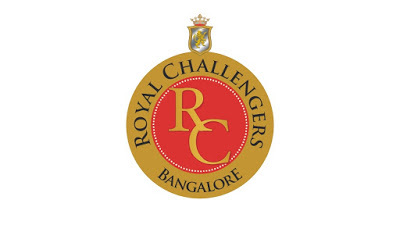 One also has to ask what is it that the other teams are doing right that RCB aren't? Granted, that the format is tough and 'it is not an easy tournament, man' as Ashwin put it after King's XI's loss against MI. But still there is something that the others are doing better than what we are.
One also has to ask what is it that the other teams are doing right that RCB aren't? Granted, that the format is tough and 'it is not an easy tournament, man' as Ashwin put it after King's XI's loss against MI. But still there is something that the others are doing better than what we are. Take Chennai Super Kings for example. They are returning to the tournament after 2 years. But they didn't have to 'rebuild'. They just teed off where they left off, and started winning matches straight away. Dhoni, who must be an avatar of Cricket God, has led them well, and whatever the man has touched has turned to gold - especially against RCB, whom he has simply tormented this year. Kolkata Knight Riders, who had a poor run in the first few years, brought in changes in the team management and structure. They turned around their fortunes and went on to win the cup twice.
Mumbai Indians are masters at nearly exiting the tournament and staging remarkable comebacks; they are well on their way to doing this again this year. King's XI Punjab have changed their team considerably and built a balanced batting/bowling unit. Even Delhi Daredevils and Rajasthan Royals have performed well at times. Sun Risers Hyderabad have been good as gold in spite of the fact that they do not have David Warner. They are sitting pretty at the top of the table. In fact, as things stand now, it may be tempting to hold the finals between SRH and CSK, and be done with the whole damn thing!
In all this, the frustrated, agonized RCB fan may well tear his hair out and say, WHY NOT RCB???!! Why are they not improving?
In the absence of any other sane or rational explanation, one is left wondering if the fortunes of the main man at the helm of affairs of RCB - the inglorious position of its owner-in-exile - has anything to do with the fate of the team itself.
A cursory look at the RCB website suggests that United Spirits Limited are still the 'founding partners' of the franchise. One has to question where this franchise is headed. What is the fate of this franchise that promises so much, but delivers so little? Who are the men behind the team; the think tank, the people who matter, those who call the shots behind the scenes? What are they doing, year after year, as the franchise flounders from one disastrous outing to another?
All we get to see is the coaching team: Daniel Vettori who is always inscrutable, Ashish Nehra who is always seen saying something to Vettori/Kohli (what does he talk about?!), and now they have added Gary Kirsten to the team (what is his role, exactly?).
Empty proclamations about 'play bold', go green initiatives, birthday dedications, harping about flash-in-the-pan performances, and even individual records of marquee players are not going to cut it.
We need that elusive cup!
Yes, the fans are asking for changes. They are getting impatient. Heads may have to roll. Radical changes may have to be made to the team management, ethos, team constitution.
Dare I say it, the franchise probably needs rescuing from the owner/s. Yes... play bold RCB. Do something... soon.
Otherwise, forget eesala, yaavasalaanu cup namdagalla!
Image source: https://4.bp.blogspot.com/-gZogLZokJS...
Published on May 05, 2018 08:09
April 11, 2018
A short descriptive video on depression
Published on April 11, 2018 02:08



